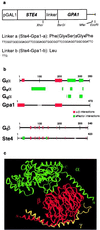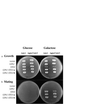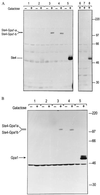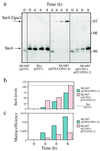Signal transduction by a nondissociable heterotrimeric yeast G protein
- PMID: 10725354
- PMCID: PMC16219
- DOI: 10.1073/pnas.97.7.3219
Signal transduction by a nondissociable heterotrimeric yeast G protein
Abstract
Many signal transduction pathways involve heterotrimeric G proteins. The accepted model for activation of heterotrimeric G proteins states that the protein dissociates to the free G(alpha) (GTP)-bound subunit and free G(betagamma) dimer. On GTP hydrolysis, G(alpha) (GDP) then reassociates with G(betagamma) [Gilman, A. G. (1987) Annu. Rev. Biochem. 56, 615-649]. We reexamined this hypothesis, by using the mating G protein of the yeast Saccharomyces cerevisiae encoded by the genes GPA1, STE4, and STE18. In the absence of mating pheromone, the G(alpha) (Gpa1) subunit represses the mating pathway. On activation by binding of pheromone to a serpentine receptor, the G(betagamma) (Ste4, Ste18) dimer transmits the signal to a mitogen-activated protein kinase cascade, leading to gene activation, arrest in the G(1) stage of the cell cycle, production of shmoos (mating projections), and cell fusion. We found that a Ste4-Gpa1 fusion protein transmitted the pheromone signal and activated the mating pathway as effectively as when Ste4 (G(beta)) and Gpa1 (G(alpha)) were coexpressed as separate proteins. Hence, dissociation of this G protein is not required for its activation. Rather, a conformational change in the heterotrimeric complex is likely to be involved in signal transduction.
Figures





Similar articles
-
Phosphorylation of the pheromone-responsive Gbeta protein of Saccharomyces cerevisiae does not affect its mating-specific signaling function.Mol Gen Genet. 1998 Jun;258(6):608-18. doi: 10.1007/s004380050774. Mol Gen Genet. 1998. PMID: 9671029
-
STE2/SCG1-dependent inhibition of STE4-induced growth arrest by mutant STE4 delta C6 in the yeast pheromone response pathway.FEBS Lett. 1995 Jun 26;367(2):122-6. doi: 10.1016/0014-5793(95)00526-f. FEBS Lett. 1995. PMID: 7796906
-
Genetic identification of residues involved in association of alpha and beta G-protein subunits.Mol Cell Biol. 1994 May;14(5):3223-9. doi: 10.1128/mcb.14.5.3223-3229.1994. Mol Cell Biol. 1994. PMID: 8164677 Free PMC article.
-
Heterotrimeric G Protein-coupled Receptor Signaling in Yeast Mating Pheromone Response.J Biol Chem. 2016 Apr 8;291(15):7788-95. doi: 10.1074/jbc.R116.714980. Epub 2016 Feb 23. J Biol Chem. 2016. PMID: 26907689 Free PMC article. Review.
-
Plant G proteins: the different faces of GPA1.Curr Biol. 2001 Oct 30;11(21):R869-71. doi: 10.1016/s0960-9822(01)00519-x. Curr Biol. 2001. PMID: 11696344 Review.
Cited by
-
WD40 Repeat Proteins: Signalling Scaffold with Diverse Functions.Protein J. 2018 Oct;37(5):391-406. doi: 10.1007/s10930-018-9785-7. Protein J. 2018. PMID: 30069656 Review.
-
Mapping the conformational landscape of the stimulatory heterotrimeric G protein.Nat Struct Mol Biol. 2023 Apr;30(4):502-511. doi: 10.1038/s41594-023-00957-1. Epub 2023 Mar 30. Nat Struct Mol Biol. 2023. PMID: 36997760
-
The GPCR heterotetramer: challenging classical pharmacology.Trends Pharmacol Sci. 2015 Mar;36(3):145-52. doi: 10.1016/j.tips.2015.01.002. Epub 2015 Feb 18. Trends Pharmacol Sci. 2015. PMID: 25704194 Free PMC article. Review.
-
Nucleotide exchange-dependent and nucleotide exchange-independent functions of plant heterotrimeric GTP-binding proteins.Sci Signal. 2019 Nov 5;12(606):eaav9526. doi: 10.1126/scisignal.aav9526. Sci Signal. 2019. PMID: 31690635 Free PMC article.
-
Distinct roles for two Galpha-Gbeta interfaces in cell polarity control by a yeast heterotrimeric G protein.Mol Biol Cell. 2008 Jan;19(1):181-97. doi: 10.1091/mbc.e07-04-0385. Epub 2007 Oct 31. Mol Biol Cell. 2008. PMID: 17978098 Free PMC article.
References
MeSH terms
Substances
LinkOut - more resources
Full Text Sources
Other Literature Sources
Molecular Biology Databases

